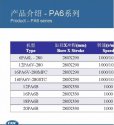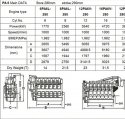Via Vincent Here is the story how China fully indigenized the French Pielstick 16PA6V-280STC diesel engine
China get the licence to built it but the French withhold the most important part of the engine the "sequential turbocharge tech " as the normal practice of licensing. Google translate
054a and 056 use diesel engine 16PA6V-280STC, a fully domesticated French engine. It's output is 7040 HP. Max output is 7750. Domestic content is 99.2%. France refused to provide the "Sequential Turbo Charging" tech. Chinese company had to come Up on its own to
From Hu Shi Shi Wei Hu Wei Shih Today
With the celebration of the 70th anniversary of the Navy's army, Shi Lang began planning at the beginning of this year, starting in late January The pen, between the other WeChat articles and the military commentary, saw the needles, dragged and pulled, and grinded and wrote for nearly three months, finally catching the last article of the naval construction history on April 23 Pushed. Although the article actually missed a lot of specific models, such as the 037 type of development after the 1980s, and the Navy a lot of plans to stay in the planning stage, but Shi Hao thought it was to sort out the basic clues. However, in the future, if you want to improve this topic, Shi Lang will have a foundation.
To say that the Navy's most critical ship power system in recent years, there is no doubt that after the introduction of Ukraine, after three rounds of localization and improvement of the GT-25000 gas turbine, but the most powerful power on the medium-sized ships in active service. System, there is no doubt that the 16PA6V-280STC diesel engine is equipped on the 054, 054A and 056 frigates. After all, 32 ships of the 054/054A type, 2 sets of the 056 type, and more than 200 diesel engines from one to the other, only those under 500 tons of marine engines are more likely to match.

Speaking of the 16PA6V-280STC diesel engine, everyone knows that this thing is something of French descent. In 1978, China signed an agreement with the French Thermal Engine Association through the China National Technical Import and Export Corporation to introduce the PA series of medium-speed high-power diesel engine patents, which was handed over to Shaanxi Diesel for trial production and manufacturing. But why did this series, which was introduced so early in China, be used in batches on domestic frigates until 2000?
This has to be carefully reviewed in the "SEMT-PIELSTICK PC2 and PA6 Diesel Engine Licensing Agreement" signed in the same year. The PA6 series diesel engines mentioned in the French agreement, although the cylinder diameter is 280 mm, single cylinder The output power is 400 horsepower, but there are two branches according to the cylinder arrangement, one is in-line, one is V-shaped, the former has 6, 8, and 9 cylinder models, the power is 2400-3600 horsepower, and the latter has 12 , 16, 18 cylinder models, power 4800-7200 horsepower.

After the introduction of PA6, the first diesel engine produced by Shaanxi Diesel was the simplest structure and the smallest 6PA6L machine. It was successfully trial-produced in May 1983. However, this 2,400-horsepower engine is mainly used for diesel locomotive models, while marine engines require at least 12-cylinder engines. Due to the complete licensing materials and parts in France, the first 12PA6V was completed in October 1983 and was approved by France the following year.
According to Chinese tradition, the new diesel engine is generally used on the military auxiliary ship to verify the relevant performance, so the first batch of 12PA6V is installed on the 918 type mine ship, and after the performance is verified, it is applied to the more important main battleship. The new batch of 12PA6V-280MPC diesel engine was used on the 037II missile boat and the 072III large landing ship in the early 1990s. It is equipped with a domestic supercharger, which also meets the needs of the two.
The 12PA6V-280MPC diesel engine on the 037II missile boat has adopted an additional boosting system method, which has improved the problem of high fuel consumption and large smoke exhaustion in the low-speed operation of the diesel engine to some extent, but the PA6 series diesel engine has to be at all speeds. To achieve satisfactory operational results within the range, a better technical approach must be used – sequential boosting techniques. The so-called sequential supercharging technology, which is later the STC (Sequential Turbo Charging) in this 16PA6V-280STC engine.

Sequential pressurization refers to two or a supercharger system consisting of two or more turbochargers connected in parallel. Its main purpose is to solve the contradiction between the diesel engine and the supercharger, improve the performance of the diesel engine under low working conditions, and at the same time, like other supercharging methods, improve the power of the diesel engine and increase the power of a single diesel engine by about 10%. At that time, STC technology was blank in China, but the French Thermal Engine Association did have STC-supercharged PA6 diesel engines, but the French were not honest. This new technology would not be easy to provide to us, and the drawings and materials were not available.
Because of the domestic products at the time, the PA6 series was the most promising diesel engine host for the next generation of medium-sized ships. Therefore, the Commission of Science, Technology and Industry for National Defense, the ship company and the Navy have made great determination to upgrade the ST6 diesel engine to STC. One difficulty, firstly, the design and prototype of the STC supercharger was developed by Harbin Engineering and Shaanxi Chai during the "Eighth Five-Year Plan" period, and was verified in a 12PA6V-280; and then according to the naval power plant during the "Ninth Five-Year Plan" period. The vision is planned to start the development of the 16PA6V-280STC diesel engine according to the power requirements of the frigate. The project started in 1996, completed the prototype motor vehicle in 1998, and completed performance verification and 200-hour endurance test in 1999. At this point, the performance of domestic diesel engines that meet the requirements of the new generation of frigates is a preliminary one.
The rated power of the 16PA6V-280STC is 7040 horsepower, and the overload power can reach 7750 horsepower. Its volume is much more compact than that of the previous generation VE390 series diesel engine. The fuel consumption is also reduced by nearly 10%. For the 3000 to 4000 tons class missile frigate The power requirement is more suitable. The only problem is that the PA6 series engine has been produced in China for many years. The 16PA6V-280STC supercharger system is also developed by itself, but the localization rate of the machine is only 73%. Considering that this type of engine is to be used in batches for our main warships, this localization rate is obviously to be improved. Therefore, in 1999, the development of the 16PA6V-280STC with a localization rate of 95.47% was launched.
The related research and development work is progressing smoothly. In 2000, the diesel engine that had to be imported in addition to the minority equipment such as the main shaft tile completed the 400-hour endurance test and passed the product appraisal. In 2001, the Navy ordered eight 16PA6V-280STC diesel engines at one time. Four units are supplied to Guangzhou Huangpu, and four units are supplied to Hudong Zhonghua – this is the eight mainframes used by the two Type 054 missile frigates. Later, with the 054A missile frigate ready to be put into mass production, the factory further developed a comprehensive localization of the 16PA6V-280STC engine, and completed the full localization and reliability improvement of the aircraft at the end of 2011, localization The rate is as high as 99.2%.
The successful development of the 16PA6V-280STC diesel engine with formal high reliability and high localization rate has guaranteed the replacement of the Chinese naval frigate diesel engine after 2000, and guaranteed the power demand of more than 80 frigates. The other PA7 series diesel engines, including the power systems of a large number of key surface ships including the large-scale tank landing ships built by the Navy in the new century, benefit from this. From this point of view, although the introduction of the PA6 series diesel engine is a special product of the "honeymoon period" between the East and the West, it can be extended to the Chinese navy's contemporary main warships, relying on the unremitting efforts of Chinese military workers. The industrial base with thick accumulation.




